|
by SAM HEDLUND IT LOOKED MORE LIKE A WORKPLACE THAN AN ORDINARY classroom. The quiet, earnest students sat at their computers, eating snacks, listening to music on headphones. Some were designing web pages, others worked with 3-D animation. Frequently, small groups of students huddled to discuss a project. At one point it became apparent that a student wasn't doing much; Louis Armin-Hoiland [at right in photo below right], the "facilitator" of the class, calmly requested that he get to work. Later, someone asked Armin-Hoiland for help with a computer problem, and he referred him to one of the student "system administrators." There was no lecture, and most of the students seemed to know more about their chosen software than Armin-Hoiland.
While many school programs are hamstrung by meager resources, the four EAST labs in Humboldt County are the beneficiaries of large federal grants. While students sit passively in other classes listening to lectures on abstract topics or faraway lands, EAST students are required to undertake work on local issues. And while most teachers judge students by how they perform on tests, EAST facilitators judge their charges by how they apply their learning to cooperative, hands-on projects.
To ensure that the power produced by the project is not wasted, the team is training students from math and science classes to do an energy audit for the school. Fortunately, Gratz-Weiser said, the school is already fairly efficient, and will likely not need many changes. [photo above right: Arel Gruenthal and Stephanie Giovannetti of Eureka High.] ONE MAN'S NOTION The EAST Initiative, as the national organization is formally called, got its start in 1995, when Tim Stephenson, an ex-police officer turned high school teacher, decided to try out a new type of learning with 20 at-risk students at Greenbrier High School in Arkansas. The idea was to de-emphasize the role of teachers and to give students more control over what they learned and how they learned it. It was also aimed at giving students the tools they would need to succeed in a society that was rapidly converting from an industrial-based economy to one based on information systems, i.e. computers. It caught on slowly. After two years, Greenbrier was still the only high school in the country with an EAST program. Things picked up in 1998, when 13 schools adopted the educational model. Today, EAST has spread to more than 200 schools in seven states. Remarkably, four of the 45 EAST schools in California -- about 10 percent -- are based in Humboldt County. EAST came to California only two years ago; Arcata High and Eureka High were among 10 schools -- out of 80 -- selected by the state Department of Education to receive $250,000 each in federal grant money to get their EAST programs up and running. Ron Perry, one of the facilitators at Eureka High, said that to receive the full funding the school had to spend the money by Sept. 30 of last year (the end of the 2001-02 federal fiscal year). He said $140,000 to $150,000 was spent on buying new computers and equipment; another $10,000 to $15,000 was used for miscellaneous supplies; and the remainder -- approximately $85,000 -- went toward student travel and training expenses. Perry said training is needed, in part, so that students can gain expertise with "high-end applications" -- such as animation software or geographic information systems (GIS), a technology with a host of potential uses, including resource management and development planning. McKinleyville and Fortuna high schools became EAST schools last year, receiving slightly less in state-distributed federal grant money: $238,000 each. Why have Humboldt schools been so successful at receiving funding to implement the EAST model? According to Matt Dozier, assistant national program director for EAST, North Coast schools have demonstrated a commitment to innovation. "It is obvious to us that the schools [in Humboldt County] have the necessary vision to implement dynamic systemic reform like EAST," Dozier said. "Having one teacher or administrator who has the sort of desire and drive to offer their students a significant educational experience like EAST is not enough. The schools in Humboldt County are doing the sorts of things that excite people. EAST is lucky to be a part of this." What makes a program like EAST so different from an ordinary computer class? "EAST is different because EAST is real," Dozier said. "There are no canned answers, no `one size fits all' projects, no answers in the back of the book; instead, there is an environment that meets kids head-on with the notion of `Let's make a difference in our community,' and, `Let's learn something.' The students respond to this well because it's not sugarcoated. No one is telling them that, `This is easy,' because it's not. Tackling real world problems is unpredictable and the tools that the kids are using are devilishly complex," he said. "[They] find it exciting and challenging." AHS facilitator Armin-Hoiland teaches EAST in a completely different way from his science classes. "In EAST classes," he said, "the students set the curriculum." That is, the students design their own projects and decide what tools to use. Nevertheless, EAST teachers like Armin-Hoiland have rigorous goals for the students. As they develop their plan, each group must write a detailed statement of what problem their project will solve and how they will solve it. Furthermore, students must explain their budget and funding plan, produce public relations materials, and explain how they will pass their project on to future students. Despite the challenges that students must meet, the democratic ideals of EAST require labs to recruit students of all backgrounds, technical abilities and intelligence levels. "We take people who have never even touched a computer," said Armin-Hoiland. Shelly Tate, an EAST training coordinator based in Sacramento, said that while the program was originally designed for underachievers, it has evolved to include students at all levels. But she said A-students sometimes have trouble adjusting. The classroom environment in which they excel, where progress is measured primarily through performance on tests, is simply not there in an EAST class. "The lower end and middle-of-the-road kids have had to really fight for what they've learned and they're sometimes more willing to dive right in" than the students with better grades, she said. AN ECOLOGICAL EMPHASIS Many EAST projects use advanced technology to work on ecological issues. To reflect this, the labs at Arcata High and McKinleyville High are known as "CEDAR academies," meaning Community Environmental Design and Restoration. Last fall, the city of Arcata's Environmental Services Department -- which in the past has worked with local schools on projects -- joined forces with Arcata High's EAST program in restoring the Winkle Site, a severely degraded tidal slough next to the Arcata Marsh. For years the slough, part of Jolly Giant Creek, ran through a narrow channel bounded by asphalt. It was finally excavated, leaving the widened waterway flanked by banks of bare, unstable dirt. The job of the students was to take the next step -- stabilize the banks, recreate fish habitat, collect in-the-field data. The ultimate goal? "Instead of running the gauntlet through a ditch, the fish will have [an] estuary channel that much more closely resembles a natural estuary," said Mark Andre, deputy director of environmental services for the city of Arcata. The first step was to find out where plants should go. "The tolerances are real narrow in terms of the habitat elevational requirements," Andre said. He added a bit of real-world pressure: "Plant material is expensive. Labor is expensive. We've got to apply the best (methods) we can so it succeeds." So far, the project appears on track. Joel Armin-Hoiland, the facilitator's son and a member of the restoration team, said recently that the students used a laser elevation rangefinder provided by the U.S. Fish and Wildlife Service to measure the elevations at which various plants would grow best. "What we've done so far," Joel said, "is we've found the ideal native vegetation areas, we've put stakes in the Winkle site to mark those areas so they can be seeded and planted. We've helped the city with putting in different kinds of trees and also putting in other kinds of animal habitat structures, like rocks and logs. [We're] also using an instrument called a salinity refractometer to study salinity of the water at the site."
Along with helping fish and preventing erosion, the project is supposed to increase the estuary's flood flow capacity. "I think it's already shown that it's beneficial for that," Andre said, "and some of the neighbors have called us to state that they think it's helped them, especially with that December storm we had." The solar project and the Winkle Site project are just two of the 15 projects underway at Arcata High School, which has 60 students in three EAST classes. [photo upper left:
Arcata High EAST crew installs a base for a solar collector.
The EAST program at McKinleyville High recently won a PG&E National Environmental Education grant, one of 11 winners out 650 applicants. The grant -- about $10,000 -- will pay for the signs as well as for GPS units small enough for kids to use on the field trips. [photo below left: McKinleyville High EAST students left to right, Scott Wallace, Logan Gloor, Bran Sorem and Morgan White. (Dave Leen not shown.)] OTHER DIRECTIONS
Perry, the EAST co-facilitator at Eureka High, said Nelson and Fouche "used EAST software to design what they wanted. They met with veteran racers such as Duane Flatmo and Al Kraus, and from that they came up with a very simple design." Perry said proudly that even though he was called to jury duty while last year's team was building the vehicle, the students did a great job without him. "They built it themselves," Perry said. "I kept talking to them during [the trial] and saying, `How you doing, how you doing, how you doing?' but in the end I came back and it was done. It was race day, and they were racing around the plaza." Four students currently enrolled in the Eureka High EAST program -- Cailin Halliday, Matt Hisatomi, Jason Wattle and Miles Thompson -- are in the final stages of building this year's entry: a kinetic sculpture called "Revenge of the Spotted Owls." Perry said the vehicle is a take-off on the school's mascot. "We're the Loggers," he explained. The pontoons of the vehicle will be decorated as logs, and the riders will wear owl costumes. In another EHS project, juniors Ariel Gruenthal and Stephanie Giovannetti are working on TribalLink, an ambitious plan to teach students and the public about Native American history and culture. The students said that their own heritage inspired the project: "My grandparents grew up in a time where it wasn't OK to talk about Native American history and the blood that was within them," Gruenthal explained. "They tend to hide the fact that they`re Native American, and therefore you tend to get a gap in knowledge. I felt that this was a way to reconnect with Native American history -- even though it's not my own tribe [Gruenthal is Cherokee and Mohawk], it's still a way to bridge the gap between the Native American community and the overall community of Humboldt County." The two students are creating a Web site and a teacher's guide on local Native American history usable for a variety of grade levels at Humboldt County schools. They are also recording an audio CD to accompany field trips to Fort Humboldt, the Clarke Museum, Indian Island and the reconstructed Yurok Sumêg Village in Trinidad. "Once you get there," Gruenthal said, "you can play the CD track, and walk around, and listen to the history." She and Giovannetti are writing historical narration for each site with the help of several local authors and historians. They are also involving other Native American students by having them record songs and stories. Dale Ann Sherman, a curator of the Clarke Museum who will be narrating part of the CD, said that she is grateful for the students' work. "The students have just been great," she said. "It is a project that is very much needed in this area. This is something that adults should have done, and it's amazing and wonderful that high school students have the concept and are doing it." The original TribalLink plan included even bigger goals: Gruenthal and Giovannetti wanted to cover every tribe north to the Oregon border and as far east as Redding, producing two CDs and a comprehensive Web site. This may happen in the next year or two as they pass the project on to new students. ORDER OUT OF CHAOS Another project at Eureka High, where the EAST lab has 92 students divided into five classes, is more mundane but could potentially be a lifesaver. Last year, a fire drill at the high school revealed just how confusing an evacuation could be. "Everyone was everywhere -- it was total chaos," said Ana Godoy, an EAST student. "We decided something needed to be done about it." [photo at right: Anna Godoy and Kailey Morse of Eureka High]
The first problem was close to resolution the day of the interview, with the students proofing a new evacuation map and procedures poster that is now displayed in every classroom. The second problem was resolved last year, when Godoy and Morse designed an alphabetical grid that was painted on the pavement outside the school. Teachers simply walk to the square that has their last initial. Godoy and Morse have not stopped with this, however. They are in the process of raising more than $1,000 to buy a first-aid kit for every classroom as well as a large outdoor storage bin for first-aid supplies, canned food and anything else that might come in handy in the event of a disaster. The bin will be placed well away from the school, so that in the event of an earthquake no one would be forced to re-enter any school building to retrieve supplies. At Fortuna High, one group of EAST students is building a Web site for the entire school. Also in process is an interactive map for the fire department created with complex GIS software. Kyla Ingram, who initiated the project, explained how it would work. Firemen will "click on a house on the map and it will tell them where the nearest fire hydrant is, and whether it will take them more time to backtrack to get to the fire hydrant," Ingram said. To make that possible, it is necessary to GPS map the locations of every fire hydrant in the city and make sure the map accurately shows some 1,500 addresses, said another student, Chris Nieto.
Finally, there's Morgan Buckman, an EAST student who's finishing up his senior year at McKinleyville High not in the traditional way -- goldbricking -- but instead by building a submarine out of PVC pipe. Next month, if all goes according to plan, he and his two teammates will take the 3- to 4-foot remotely piloted vehicle to the Massachusetts Institute of Technology. There they will compete in a contest sponsored by the Marine Advanced Technology Education Center, located at Monterey Peninsula College. In the competition, tethered miniature submarines will attempt to maneuver into a model representing part of the Titanic. Using a live video feed from the sub, contestants must guide their creations through narrow doorways and enter several rooms in the darkened interior, where a previous submarine supposedly dropped sampling probes. They will try to pick up sections of pipe representing the probes and carry them back to the surface, all within 20 minutes. "We think we're going to do an arm and a cage on top of it, to hold what it pulls out," Buckman said. He plans to use model car motors to power ducted-fan propellers that will provide both thrust and steering. Buckman said that they would use AutoCAD design software to draw the final design. Once he completes the sub, he hopes to gain permission to practice maneuvering in the Arcata Community Pool. THE FUTURE Nationally, EAST is focusing this year on starting programs in middle schools. In line with that, the Eureka High EAST lab is seeking as much as $262,000 in federal funds to bring the educational model to Zane and Winship middle schools. The Eureka EAST folks aren't being completely altruistic, as $25,000 would go to them to cover the cost of training middle school students in EAST techniques. "We'd become the mentor lab," explained Jennifer Johnson, a facilitator in the Eureka EAST program. There has also been talk of expanding EAST to Humboldt State University. The cost of having an innovative educational program is that you frequently have to seek alternative sources of funding. In Arkansas, EAST programs are funded yearly as a line item in the state budget; that is not the case in California, although there are efforts underway to bring that about here. While Fortuna High receives a small amount from its school district -- $2,000 to $3,000 -- the local EAST programs at present are basically on their own in terms of future funding. Given that they were started by such large grants, the programs aren't in any jeopardy; nonetheless, no one's sitting on their hands. The Eureka EAST lab, for example, has raised about $3,000 through fund-raisers such as dances and car washes. Additionally, the program is in the process of applying to a foundation for a $200,000 grant; Johnson said the money would go toward purchasing 10 wireless laptops for the lab, and additional computers for the school's library. Bottom line: Finding money is likely to be a challenge. But then, challenge appears to be what EAST is all about. Sam Hedlund is a freelance writer based in Arcata. Editor Keith Easthouse contributed to this report. IN THE NEWS | ART BEAT | GOOD NEWS | CALENDAR
Comments? © Copyright 2003, North Coast Journal, Inc. |

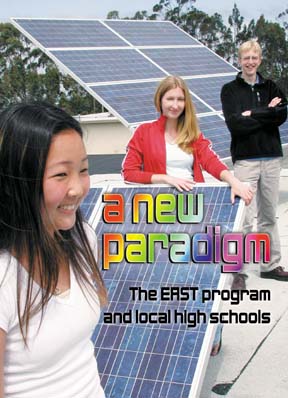
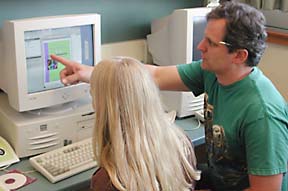 This
is the Environmental and Spatial Technology (EAST) lab at Arcata
High School, where a powerful new experiment in education is
rapidly becoming routine. Eureka High, McKinleyville High and
Fortuna High are also participating in the EAST initiative. The
four schools, along with high schools from as far away as Ukiah
and Vallejo, showcased their top projects at a regional EAST
conference held last week at the Adorni Center in Eureka. On
hand, in addition to a host of students and teachers, were national
representatives from the EAST organization, a nonprofit educational
group. The various presentations and workshops covered everything
from video software to grant writing to a designed-on-the-computer
cycling contraption that Eureka High students will enter in this
weekend's Kinetic Sculpture Race. [photo
below left: Eureka High kinetic sculpture, "Revenge of the
Spotted Owls."]
This
is the Environmental and Spatial Technology (EAST) lab at Arcata
High School, where a powerful new experiment in education is
rapidly becoming routine. Eureka High, McKinleyville High and
Fortuna High are also participating in the EAST initiative. The
four schools, along with high schools from as far away as Ukiah
and Vallejo, showcased their top projects at a regional EAST
conference held last week at the Adorni Center in Eureka. On
hand, in addition to a host of students and teachers, were national
representatives from the EAST organization, a nonprofit educational
group. The various presentations and workshops covered everything
from video software to grant writing to a designed-on-the-computer
cycling contraption that Eureka High students will enter in this
weekend's Kinetic Sculpture Race. [photo
below left: Eureka High kinetic sculpture, "Revenge of the
Spotted Owls."]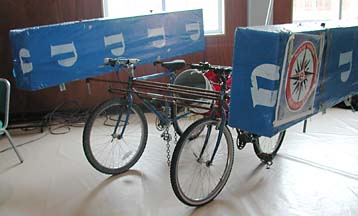 The
result of one such project can be found on the roof of Arcata
High, where a set of solar panels sends two-and-a-half kilowatts
of power through alternators directly into the school's electrical
system. The photovoltaic array is a small-scale experiment, large
enough to power a typical house but unable to put much of a dent
in the school's $83,000 yearly electricity bill. "What we're
really trying to do is show the possibilities of solar power
and alternative energy," said Rowan Gratz-Weiser, 17, one
of four students involved in the project. One of the arrays,
he explained, can swivel in any direction on a base that the
students designed and the school's metal shop built. Their tests
so far show that west-facing panels lose sun in the morning,
but regain the advantage in the afternoon, producing 80 to 90
percent as much as a south-facing array. For this project, advanced
drafting software and other applications were not needed. They
designed the base in a simple drawing program, according to team
member Toby Haskett.
The
result of one such project can be found on the roof of Arcata
High, where a set of solar panels sends two-and-a-half kilowatts
of power through alternators directly into the school's electrical
system. The photovoltaic array is a small-scale experiment, large
enough to power a typical house but unable to put much of a dent
in the school's $83,000 yearly electricity bill. "What we're
really trying to do is show the possibilities of solar power
and alternative energy," said Rowan Gratz-Weiser, 17, one
of four students involved in the project. One of the arrays,
he explained, can swivel in any direction on a base that the
students designed and the school's metal shop built. Their tests
so far show that west-facing panels lose sun in the morning,
but regain the advantage in the afternoon, producing 80 to 90
percent as much as a south-facing array. For this project, advanced
drafting software and other applications were not needed. They
designed the base in a simple drawing program, according to team
member Toby Haskett.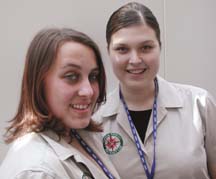 To
make the project happen, the group of students -- Gratz-Weiser
and Haskett, along with Lisa Kim and Beth Rickard -- needed money.
They wrote their own grant proposal with the input of Armin-Hoiland,
and outclassed hundreds of submissions -- almost all written
by adults -- to win a $10,000 Toyota Tapestry grant, one of 50
awarded by the National Science Teachers Association last year.
This March they presented their work at the association's convention
in Philadelphia. (The students were able to make the trip with
the help of the Humboldt Area Foundation.)
To
make the project happen, the group of students -- Gratz-Weiser
and Haskett, along with Lisa Kim and Beth Rickard -- needed money.
They wrote their own grant proposal with the input of Armin-Hoiland,
and outclassed hundreds of submissions -- almost all written
by adults -- to win a $10,000 Toyota Tapestry grant, one of 50
awarded by the National Science Teachers Association last year.
This March they presented their work at the association's convention
in Philadelphia. (The students were able to make the trip with
the help of the Humboldt Area Foundation.)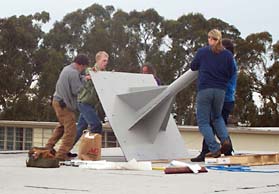
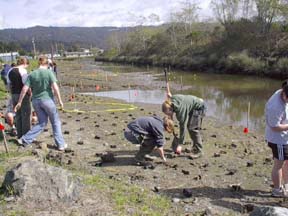 The
CEDAR academy over at McKinleyville High is helping restore native
species to the forest along the Hammond Trail through vegetation
(particularly ivy) removal and planting. Additionally, plans
are in the works to lead younger students on educational field
trips to the area; to develop "curriculum packets"
with information about local plants for grades four to five and
six to eight; to install two signs on the Hammond Trail with
information about plant species; and to develop a computerized
map of the trail. Referring to the curriculum packets, Debbie
Cyphers, a junior, said they are "being edited right now,
and we hope to have it to teachers by the end of this [school]
year."
The
CEDAR academy over at McKinleyville High is helping restore native
species to the forest along the Hammond Trail through vegetation
(particularly ivy) removal and planting. Additionally, plans
are in the works to lead younger students on educational field
trips to the area; to develop "curriculum packets"
with information about local plants for grades four to five and
six to eight; to install two signs on the Hammond Trail with
information about plant species; and to develop a computerized
map of the trail. Referring to the curriculum packets, Debbie
Cyphers, a junior, said they are "being edited right now,
and we hope to have it to teachers by the end of this [school]
year."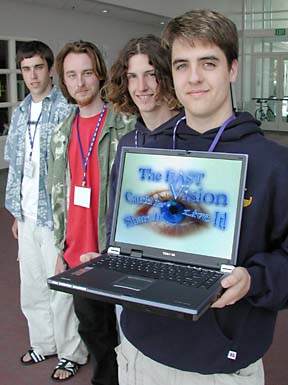 The
local EAST programs are branching beyond environmental work.
One rather unique effort was on display at the Adorni last week:
a cycling machine that achieved the fastest overall time of any
vehicle entered in last year's Kinetic Sculpture Race. It was
designed by former Eureka High EAST students Tate Nelson
and Matt Fouche.
The
local EAST programs are branching beyond environmental work.
One rather unique effort was on display at the Adorni last week:
a cycling machine that achieved the fastest overall time of any
vehicle entered in last year's Kinetic Sculpture Race. It was
designed by former Eureka High EAST students Tate Nelson
and Matt Fouche.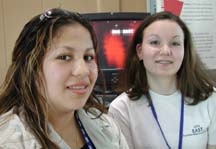 Godoy,
along with fellow EAST student Kailey Morse, did just that, and
have basically rethought the high school's entire disaster preparedness
planning. "We went and talked with the administration, and
we worked with the fire department to figure out new procedures
to make the evacuation much faster, and also to make the counting
procedure [to keep track of] the students much more effective."
Godoy,
along with fellow EAST student Kailey Morse, did just that, and
have basically rethought the high school's entire disaster preparedness
planning. "We went and talked with the administration, and
we worked with the fire department to figure out new procedures
to make the evacuation much faster, and also to make the counting
procedure [to keep track of] the students much more effective."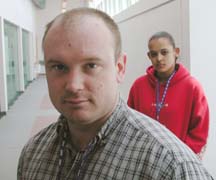 Inputting
such data into the computer has proven laborious. But when the
map is finished, it should be able to show the quickest route
to any address and the nearest hydrant to a fire. Fortuna High
facilitator Errin Odell, a former firefighter, [at left in photo at left, with student
Kyla Ingram] said the map, by improving
response times, could provide better protection to both firemen
and residents.
Inputting
such data into the computer has proven laborious. But when the
map is finished, it should be able to show the quickest route
to any address and the nearest hydrant to a fire. Fortuna High
facilitator Errin Odell, a former firefighter, [at left in photo at left, with student
Kyla Ingram] said the map, by improving
response times, could provide better protection to both firemen
and residents.